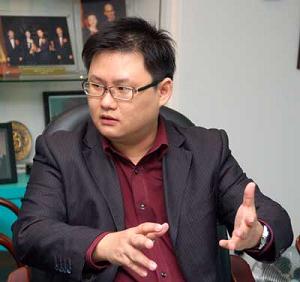
CEO Lin Wenchang: Based on the current orderbook and increasing enquiries from both existing and new customers, we believe we are on a recovery trend. Photo by Sim Kih
CHINA TAISAN’S management believes that 3Q09 marks the textile cycle bottom as its sales volumes are recovering, as are gross margins, utilization rates and earnings.
Its CEO Lin Wenchang explained at a recent investor briefing: “Orders had slowed down during the first half of the year as sports apparel makers had been winding down excess inventory stocked up from last year’s Olympic games, but restocking is back.”
Despite 3Q being a seasonally weak quarter, net 3Q09 earnings of Rmb 7.1 million were almost double that of 2Q09, signifying a bottoming-out.
Performance fabrics continued to be the main sales contributor.
On 12 Nov, Taisan announced it had secured Rmb 94.5 million worth of orders. This is in addition to its announcement on 15 Oct of an order book of Rmb 205 million.
The new orders resulted in a rise in capacity utilization to about 85% to 90% since the beginning of 4Q09, from a low of about 50% in 2Q09 and 3Q09.
The management appeared upbeat at the briefing last week, and updated investors on its progress of listing American Depositary Receipts (ADR) with the help of the Bank of New York Mellon.
The owner of an ADR has the right to obtain the foreign stock it represents, but US investors usually find it more convenient simply to own the ADR.

3Q09 net profits doubled q-o-q from 2Q09, signifying a bottoming out.
The price of an ADR often tracks the price of the foreign stock in its home market, adjusted for the ratio of ADRs to foreign company shares.
Below is a summary of the Q&A discussion with China Taisan’s management at the recent investor meeting:
Q: How does widespread capacity ramp-up by Chinese textile factories affect you?
We are focused on the production of mid- to high performance fabric products. Our close collaboration with many of the established apparel brands provides us with a strong competitive edge over our peers.
Most of the ramp-up is done by factories that produce the mass market fabrics, those with a lower quality relative to Taisan.

CFO Patrick Kan: ADR valuation is dependent on market sentiment. Photo by Sim Kih
Q: Your utilization is already 85% to 90%. Do you foresee a need to expand capacity?
Our production resources are currently allocated to both high-end and mid-range products.
I prefer to shift production away from mid-range products to the higher-end products. This will expand our gross margins. I do not foresee having to add equipment in the immediate term of 3 months.
Also, we have plans to extend our range of product offerings and strengthen our fabric finishing capabilities.
Q: Are most orders flowing in from repeat customers? What’s the new customer composition?
Most orders (about 80% of volumes) are from repeat customers.
We usually get new customers by launching new products at the annual Beijing Fabric Exhibition and the Shanghai International Fabric Exhibition.
We prefer to work with repeat customers, with the more established brand names in China, such as Li Ning, Metersbonwe, 361-degree, Anta and Xtep. Orders and payment from these customers tend to be more stable.
Q: Will 4Q09 gross margins recover?
Gross margin is a function of raw material cost, our capacity utilization rate and the overall market demand. At present, we are enjoying a utilization of approximately 85%-90%, as compared to 50% in 2Q09 and 3Q09.
We expect the increased economy of scale to help raise our gross margin in 4Q09.
Secondly, there is a shift of demand from the lower-margin products to higher-margin products as the general outlook for next year's apparel market recovers.
Q: What is your cost structure?
Raw materials comprise over 70% of cost of sales. Labor comprise about 7% to 8%. The remaining are operating overheads.
CHINA TAISAN | |
| Stock price | 18.5 cts |
| Market capitalisation | S$171.7 million |
| Dividend yield | 9.7% |
| Net cash | Rmb 315.4 million |
| PE | 2.8 X |
We are setting up our facility at level 1 to enable Singapore shareholders to convert shares into ADRs that can be traded in America.
At level 1, these ADRs can be traded only on OTC, and we will need a market maker to start the trading.
Q: Will your listing fees increase when you file with SEC?
For our current purpose, we only incur legal and investor relations fees. There is no material impact on our profit and loss statement yet.
Q: Since you will not be traded on an US exchange, what benefit is there at level 1?
We will have a good platform where we can start attracting more US institutional interest and broaden our investor base.
Many US funds are interested in China’s consumption growth stories and China Taisan is a direct beneficiary of China’s growing retail spending.
Consumption demand for upmarket lifestyle apparel is still growing. Some fund managers foresee demand for higher-end sports and leisure apparel (from the likes of Li Ning) to grow not only in the 1st tier cities, but even more so in the 2nd to 3rd-tier cities in inland China, in the northeast, and in the west.
The setting up of an ADR facility will enable US fund managers licensed to trade ADRs to invest in us without having to bear any cross border transaction costs and or put up with time differences.
Q: Now that you are having an earnings recovery, what will FY2009 dividend payout be like?
We are still commited to pay at least 30% of net profit attributable to shareholders in FY2009.
Recent story: CHINA TAISAN: Enjoying growing orders from sportswear makers

